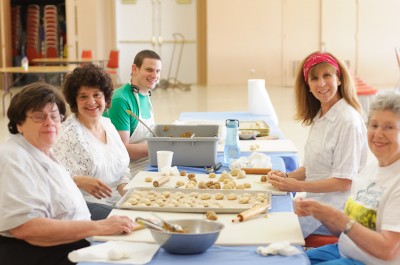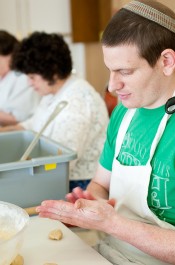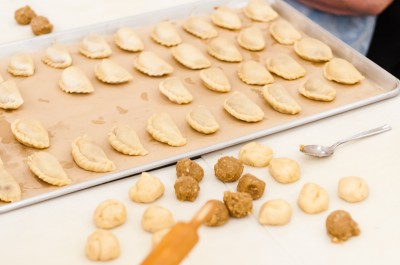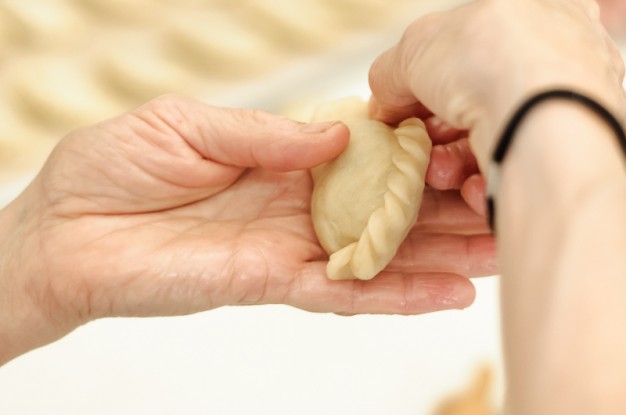Sephardic Bikur Holim Bazaar – A Delicious Link to the Past
I’m Jewish, from the Ashkenazi tradition – the group you probably associate with Judaism, emanating from Eastern Europe. When you think of bagels and latkes and schmalz, you are thinking of Ashkenazi. The other major group of jews, called Sephardic, are from Southern Europe and North Africa. As I’ve mentioned before, I had the great fortune to marry into a Sephardic family that has deep roots (over 100 years) in Seattle but maintains many traditions from the old country.
 Like most immigrant communities, food is integral to those traditions. Sephardic cuisine, at least in my family, incorporates many of the ingredients and flavors that you would associate with Spain, Turkey, and Greece but without a lot of spicing. The most famous dishes are pastries and breads, both savory and sweet. There are a variety of doughs that are used to make delights such as bulemas, burekas, boyikos, panderas, filas, etc. Fillings range from feta and spinach to potato to pumpkin.
Like most immigrant communities, food is integral to those traditions. Sephardic cuisine, at least in my family, incorporates many of the ingredients and flavors that you would associate with Spain, Turkey, and Greece but without a lot of spicing. The most famous dishes are pastries and breads, both savory and sweet. There are a variety of doughs that are used to make delights such as bulemas, burekas, boyikos, panderas, filas, etc. Fillings range from feta and spinach to potato to pumpkin.
The Sephardic Bikur Holim congregation has always been the center of Sephardic life in Seattle. Way back in 1962 they began a tradition of holding an annual bazaar (market) to raise money as well as provide a great social event. Baking for the bazaar would take place on dozens of days over several months leading up to the event. Ten years ago, the Bazaar tradition lapsed as it became too much work for the older generation to run.
 This year, Chef Eli Varon (pictured left), who does a ton of volunteer work at the shul decided it was time to bring it back. If you want to check it out, there is a Facebook page with lots of fun pictures. If you are in the Seattle area, you should come! It is in the congregation social hall on Sunday, September 9, 2012 from 9:00 am to 3:00 pm at 6500 52nd Ave S, Seattle, Washington 98118 in Seward Park. It is very much open to the public and there will be a lot of things to eat that you’ll never find anywhere else.
This year, Chef Eli Varon (pictured left), who does a ton of volunteer work at the shul decided it was time to bring it back. If you want to check it out, there is a Facebook page with lots of fun pictures. If you are in the Seattle area, you should come! It is in the congregation social hall on Sunday, September 9, 2012 from 9:00 am to 3:00 pm at 6500 52nd Ave S, Seattle, Washington 98118 in Seward Park. It is very much open to the public and there will be a lot of things to eat that you’ll never find anywhere else.
Unfortunately, I only got to bake for one morning, but the experience was enlightening. We were making pastries called travados. Eli mixed a simple dough with flour, oil, and white wine, and we wrapped it around a filling made from ground walnuts and almonds spiced with cinnamon and cloves. The tricky part – there is always a tricky part – is the repulgo, the method of beautifully crimping the edge. The top photo is my wife’s cousin Ellie completing a perfect repulgo.
Eli and all of the volunteers could do the repulgo in seconds, with lovely, evenly spaced twists. After trying dozens of them, it was still taking forever and they were still awkward looking. But it was good fun trying! This is one of those things I’m not even going to try and describe, because the only way you can really learn is with a master. The details are subtle – pinch but don’t pull, flick each fold over with the back of your thumb, not too thick or too thin…
I didn’t get to see this part, but apparently after the travado is baked, it will be dipped in a honey caramel and then finished with sesame seeds, and if that doesn’t sound good to you, you may want to check your pulse.
 Here is a recipe for travados from the Rhodes Jewish Museum. I can’t in good conscience suggest you go follow it though. There is simply too much implicit knowledge about exactly what the dough should feel like, how to mix it and roll it and fold it, that isn’t captured in the simple-sounding text. Instead, maybe you should visit a seasoned citizen you know that knows how to make beautiful bulemas or tamales or pierogi or macarons or tea cakes or kifli or pista burfi and finally learn how, before that knowledge is lost. And then teach your kids.
Here is a recipe for travados from the Rhodes Jewish Museum. I can’t in good conscience suggest you go follow it though. There is simply too much implicit knowledge about exactly what the dough should feel like, how to mix it and roll it and fold it, that isn’t captured in the simple-sounding text. Instead, maybe you should visit a seasoned citizen you know that knows how to make beautiful bulemas or tamales or pierogi or macarons or tea cakes or kifli or pista burfi and finally learn how, before that knowledge is lost. And then teach your kids.


I love that first picture! Those pastries look so pretty;and sound so good:)
This looks amazing and is similar to our own version of “empanadas” – which Filipinos attribute to the Spanish influence in our food and culture. I was intrigued by the white wine in the pastry. Does the wine have to be chilled when added to the flour? Thanks for sharing this historical background and recipe, Michael !
Hey Betty Ann – As far as I know, the white wine wasn’t chilled. I think if you were using it in a butter dough where you are trying to keep everything cold, that would be a good idea, but probably not necessary in this oil dough.
Hi Michael, thank you for this post: so informative and interesting. You know, I’ve been doing the repulgo edges on my pasta and other dough creations for so many years just for fun, and never knew where it came from and what’s the name of that elegant edge. Baking for bazaar is a great tradition, would be nice to have it in each community so people can taste the World, share their stories, learn from one another and be friends… 🙂
Thank you so much for posting this…I grew up on Borekas (though we tended toward the savory versions) and now even my Ashkenazi husband requests them for his birthday…I sent this to my many boreka making relatives and a few boreka making friends. Wish I were up in Seattle for this event!
I love how you shared both tradition, community, and food knowledge in this post. They sound delicious. I just tried making my first-ever ravioli (gluten-free). While it was edible, it certainly wasn’t blog-worthy, and I will keep on trying.
This Bazaar is wonderful and I’m delighted Eli is bringing it back! Sephardic cuisine is the best – you are fortunate to have recipes and traditions in your family. And you are so right that you really cannot just follow a recipe, but rather need to learn from someone experienced. We need to keep these traditions alive! I had a blast making borekas with a group of Sephardic women for a friend’s son’s bar mitzvah – my rolling never came close to theirs but I learned a lot!
I have eaten this when my friend visited my home. She learned the recipe for the cookbook. I am trying to learn how to make this one. Do you have some tips on how to make it simpler to do?
Hey A.M. –
No, really, I don’t even feel like an expert on this one myself yet, so no particular thoughts on how to make it simpler. I think this is more one of those labor of love projects :).
This was a great event!! I can’t wait to try the goodies! I wouldn’t have known about it until you posted about it. We definitely came out enriched by the experience and have split 6 kinds of goodies with friends. Thanks for sharing!!
I’m so glad you came out!
Can’t wait to try the travados. All them nuts and seeds must make it highly nutritious, full of omega oils, proteins, phytochemicals, minerals… You could forget how good they look, I bet they’re super tasty. Thanks again herbivoracious man for sharing great food